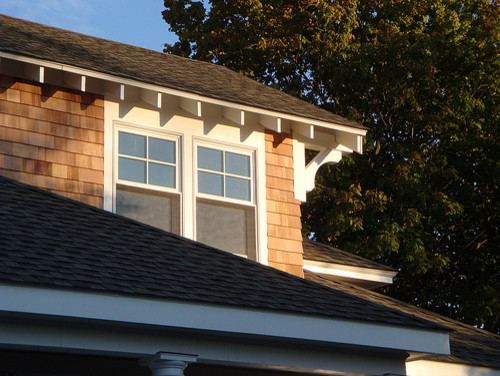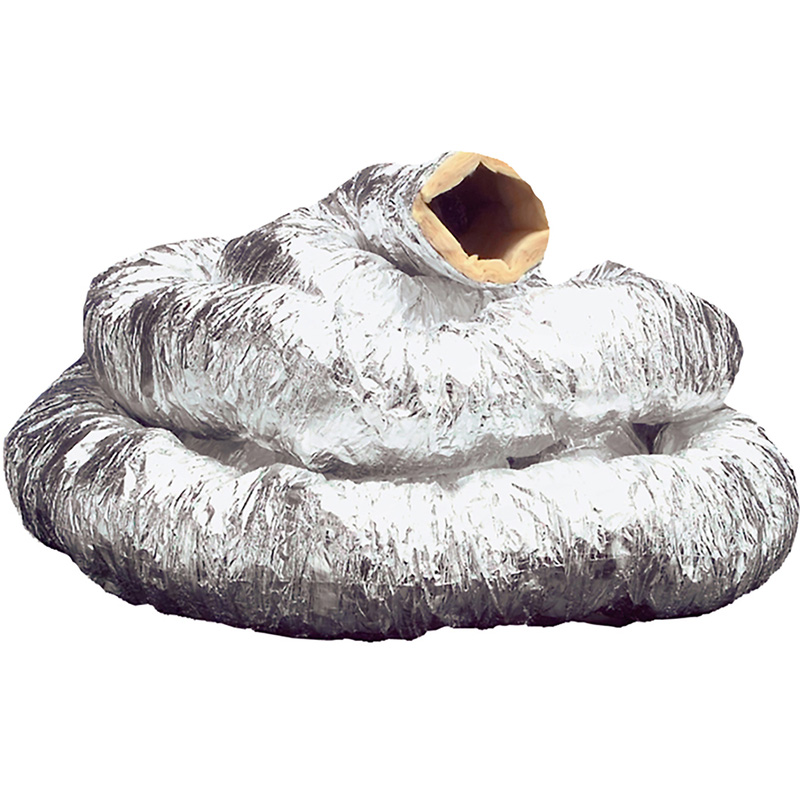We’d like to remind Forumites to please avoid political debate on the Forum.
This is to keep it a safe and useful space for MoneySaving discussions. Threads that are – or become – political in nature may be removed in line with the Forum’s rules. Thank you for your understanding.
📨 Have you signed up to the Forum's new Email Digest yet? Get a selection of trending threads sent straight to your inbox daily, weekly or monthly!
Help with bathroom extraction from the loft

ashe
Posts: 1,574 Forumite






We just had our main bathroom and en suite done. Previously the en suite had a weak extractor fan in the wall, with no heating, and the main bathroom had heating but no extractor fan. Well there was space for one, but it was panelled over with those fake tile panel things.
now en suite has heating and both rooms have in-line fans in the loft ducted from the ceiling. When our installer went to install them, he found that underneath our soffits and facias was the old wood, which wasn't soffits and facias, but what I believe is known as exposed rafter tails. This isn't our house but gives an idea:

Then the UPVC Soffits/facias are installed on top of that.
He has created the external vent in the soffit but when he has gone to connect the ducts to the vent from the loft/outside, he's found the wood board to be in the way. I was out at the time, and he explained the solution was to drill several large holes in the wood to allow the air from the extractors through and to flow out of the soffit vent.
I'm not entirely happy with this solution as I feel like warm, damp air is just going to get vented into the soffit area through wood which will eventually rot, so I am exploring options of using a roof tile vent to extract to.
Unfortunately from what I can see, these seem to require a condensation trap to be installed:

and all the videos I've seen of these they have a drain connector to hook up to something (the nozzle on the left). We don't have a waste pipe or anything in our loft. Any ideas how I can go about this?
now en suite has heating and both rooms have in-line fans in the loft ducted from the ceiling. When our installer went to install them, he found that underneath our soffits and facias was the old wood, which wasn't soffits and facias, but what I believe is known as exposed rafter tails. This isn't our house but gives an idea:

Then the UPVC Soffits/facias are installed on top of that.
He has created the external vent in the soffit but when he has gone to connect the ducts to the vent from the loft/outside, he's found the wood board to be in the way. I was out at the time, and he explained the solution was to drill several large holes in the wood to allow the air from the extractors through and to flow out of the soffit vent.
I'm not entirely happy with this solution as I feel like warm, damp air is just going to get vented into the soffit area through wood which will eventually rot, so I am exploring options of using a roof tile vent to extract to.
Unfortunately from what I can see, these seem to require a condensation trap to be installed:

and all the videos I've seen of these they have a drain connector to hook up to something (the nozzle on the left). We don't have a waste pipe or anything in our loft. Any ideas how I can go about this?
0
Comments
-
I'm curious to know the answer, as we have a through-roof extractor with no condensation trap. Ours is through the roof of a single storey extension so the duct doesn't pass through a cold loft space - maybe that's why it was acceptable in our case?
Could the drain connector from the condensate trap connect to an overflow pipe discharging at the eaves, with the water going onto the ground below or onto a lower level roof and to the guttering that way? I don't know if this is acceptable (to you or in terms of building regulations) but I'd personally consider it given that the volume of water will be small.0 -
We had a roof tile vent fitted for our bathroom extractor a couple of years back. As long as your ducting doesn't have any flat sections, you'll be fine without a condensation trap. It's also worth using insulated ducting as that will reduce any condensation forming (it also helps reduce noise from the extractor).
I mounted our inline extractor to the roof timbers to reduce vibration on the ceiling. A length of insulated ducting runs almost vertically down to the bathroom ceiling vent. Insulated ducting then runs from the outlet of the extractor a short distance at an upwards angle to the roof tile vent. I cut the ducting to the correct size to reduce sagging and it's been tied to the rafters where needed for support.0 -
Sorry just but-in, but could a through roof extractor be connected an existing soil pipe vent with a non return valve?4.29kWp Solar system, 45/55 South/West split in cloudy rainy Cumbria.0
-
I think that's how many of them do it. Assuming you mean the condensation trap anyway, not the air vent! in which case dont think that would be a good idea but who knows lolSpies said:Sorry just but-in, but could a through roof extractor be connected an existing soil pipe vent with a non return valve?
Yes I think in your case its fine because yours isn't going through a cold space like mine. We have crap insulation as well, but are waiting on all our work being done before getting it insulated. This might be a shout actually as we have our boiler in the loft and it goes into the guttering (even though it shouldnt, it was just like that when we moved in and there isnt really any other option)casper_gutman said:I'm curious to know the answer, as we have a through-roof extractor with no condensation trap. Ours is through the roof of a single storey extension so the duct doesn't pass through a cold loft space - maybe that's why it was acceptable in our case?
Could the drain connector from the condensate trap connect to an overflow pipe discharging at the eaves, with the water going onto the ground below or onto a lower level roof and to the guttering that way? I don't know if this is acceptable (to you or in terms of building regulations) but I'd personally consider it given that the volume of water will be small.0 -
ashe said:We just had our main bathroom and en suite done. Previously the en suite had a weak extractor fan in the wall, with no heating, and the main bathroom had heating but no extractor fan. Well there was space for one, but it was panelled over with those fake tile panel things.
now en suite has heating and both rooms have in-line fans in the loft ducted from the ceiling. When our installer went to install them, he found that underneath our soffits and facias was the old wood, which wasn't soffits and facias, but what I believe is known as exposed rafter tails. This isn't our house but gives an idea:
Then the UPVC Soffits/facias are installed on top of that.
He has created the external vent in the soffit but when he has gone to connect the ducts to the vent from the loft/outside, he's found the wood board to be in the way. I was out at the time, and he explained the solution was to drill several large holes in the wood to allow the air from the extractors through and to flow out of the soffit vent.
I'm not entirely happy with this solution as I feel like warm, damp air is just going to get vented into the soffit area through wood which will eventually rot, so I am exploring options of using a roof tile vent to extract to.
Unfortunately from what I can see, these seem to require a condensation trap to be installed:
and all the videos I've seen of these they have a drain connector to hook up to something (the nozzle on the left). We don't have a waste pipe or anything in our loft. Any ideas how I can go about this?Condensation traps trap WATER leaking back into the bathroom from the duct. They don't trap any moisture in the air and don't solve your problem.IMO, the 'solution' your installer offered is inappropriate too.
0 -
Surely that is my problem? The water in the duct is coming from the air as it condenses?grumbler said:ashe said:We just had our main bathroom and en suite done. Previously the en suite had a weak extractor fan in the wall, with no heating, and the main bathroom had heating but no extractor fan. Well there was space for one, but it was panelled over with those fake tile panel things.
now en suite has heating and both rooms have in-line fans in the loft ducted from the ceiling. When our installer went to install them, he found that underneath our soffits and facias was the old wood, which wasn't soffits and facias, but what I believe is known as exposed rafter tails. This isn't our house but gives an idea:
Then the UPVC Soffits/facias are installed on top of that.
He has created the external vent in the soffit but when he has gone to connect the ducts to the vent from the loft/outside, he's found the wood board to be in the way. I was out at the time, and he explained the solution was to drill several large holes in the wood to allow the air from the extractors through and to flow out of the soffit vent.
I'm not entirely happy with this solution as I feel like warm, damp air is just going to get vented into the soffit area through wood which will eventually rot, so I am exploring options of using a roof tile vent to extract to.
Unfortunately from what I can see, these seem to require a condensation trap to be installed:
and all the videos I've seen of these they have a drain connector to hook up to something (the nozzle on the left). We don't have a waste pipe or anything in our loft. Any ideas how I can go about this?Condensation traps trap WATER leaking back into the bathroom from the duct. They don't trap any moisture in the air and don't solve your problem.IMO, the 'solution' your installer offered is inappropriate too.
changing from venting out of the soffits to venting out of a roof tile, and all the extractor fan websites and info I can find on google state If venting vertically a condensation trap is needed, and my problem is how to deal with the overflow from the condensation trap?0 -
Yes, you are right. I missed that you mentioned the roof tile vent and thought you wanted to use the trap to capture the moisture from the air.In the original design, If there was no soffit, the water would be dripping/leaking from the vent down, along the wall.With a vertical duct and a trap, I don't see why you can't stick out a plastic pipe through the facscial/soffit, similar to a traditional overflow pipe.
0 -
This is probably what I would do too. Venting the extractor into the void between rafters & fascia would be a big no.grumbler said: With a vertical duct and a trap, I don't see why you can't stick out a plastic pipe through the facscial/soffit, similar to a traditional overflow pipe.
Any language construct that forces such insanity in this case should be abandoned without regrets. –
Erik Aronesty, 2014
Treasure the moments that you have. Savour them for as long as you can for they will never come back again.0 -
Thanks - I will draw a diagram up around how it is currently installed and what I propose to do and what I think I need to order and report back, as I am keen for this to be done right. I purposefully bought decent fans as I wanted to have good extraction, and feel like this is a bit of a bodge solution. I'd rather he had just told me there was a problem and I could have gotten someone else in rather than trying a "well, its working" solution.0
-
none of what you said there is really clear, but going off that it sounds like its not possible to get a duct from the loft down to the soffit because somethings in the way?fair enough, if so you have 2 options, pay them more for the extra work to be required in order to get a duct from the loft to the soffit (may or may not be possible) or if that doesn't work get a roofer to install a vented tile/duct and flashing kit and connect to that using insulated ductashe said:"When our installer went to install them, he found that underneath our soffits and facias was the old wood, which wasn't soffits and facias"
He has created the external vent in the soffit but when he has gone to connect the ducts to the vent from the loft/outside, he's found the wood board to be in the way.0
Confirm your email address to Create Threads and Reply

Categories
- All Categories
- 352.9K Banking & Borrowing
- 253.9K Reduce Debt & Boost Income
- 454.7K Spending & Discounts
- 246K Work, Benefits & Business
- 602K Mortgages, Homes & Bills
- 177.8K Life & Family
- 259.9K Travel & Transport
- 1.5M Hobbies & Leisure
- 16K Discuss & Feedback
- 37.7K Read-Only Boards





